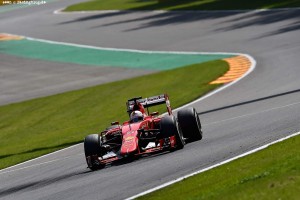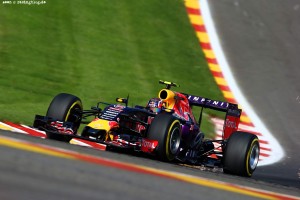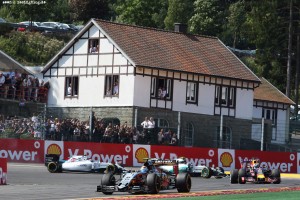Race Strategy was at the heart of the big story coming out of the Belgian Grand Prix, as Ferrari and Sebastian Vettel attempted to get to the end of the race on a one stop-strategy and suffered a tyre failure, which Pirelli blamed on excessive wear.
Spa was one of those weekends where the teams went into the race with limited knowledge of how the tyres would perform on race day. Friday afternoon practice, where teams do their long run tests, was interrupted twice due to accidents and red flags. So no one had a clear picture of how far you could go on the soft and medium compound Pirellis in terms of wear and what the degradation in performance would be over a longer run. Most teams were briefing that it would be a two-stop race, with some teams perhaps getting marginal on degradation and needing a third stop. No one was contemplating a one-stop for the 44-lap race.
Vettel vs Grosjean – Ferrari’s plan
 After qualifying badly, starting 8th on the grid, Vettel found himself in a strong fifth place on Lap 2. It became clear that his competition for a podium was from Romain Grosjean, who pitted aggressively on Lap 9 and got ahead of Bottas in the process. Ferrari decided to run a longer first stint to Lap 14 and to put him onto the medium tyres for the middle stint, the idea being that Vettel would have a tyre offset of five laps against Grosjean later in the race. So the plan at that point was clearly to switch to soft tyres for a short final stint and to attack Grosjean in the closing laps.
After qualifying badly, starting 8th on the grid, Vettel found himself in a strong fifth place on Lap 2. It became clear that his competition for a podium was from Romain Grosjean, who pitted aggressively on Lap 9 and got ahead of Bottas in the process. Ferrari decided to run a longer first stint to Lap 14 and to put him onto the medium tyres for the middle stint, the idea being that Vettel would have a tyre offset of five laps against Grosjean later in the race. So the plan at that point was clearly to switch to soft tyres for a short final stint and to attack Grosjean in the closing laps.
However the one problem with this plan was if there were a Safety Car or a Virtual Safety Car between laps 19-23, where he would be compromised as his rivals around him on soft tyres would pit and be able to move to a set of medium tyres that would take them to the finish.
The nightmare scenario came true; when the VSC was deployed on Lap 21, Ferrari was in trouble. Grosjean, Perez, Raikkonen all pitted and effectively took a pit stop in half the normal time. Usually you lose 18 seconds against a competitor making a stop at racing speeds. Under the VSC it is reduced to 10 secs, because the whole field on track is circulating at reduced speed.
So this greatly complicated life for Vettel, because the other cars that had stopped under the VSC were now in that all impiortant 18-second pit window behind Vettel. So it was clear that when Vettel went in to pit for softs later in the race he would have to pass some or all of them on his fresher tyres.
When the VSC was depleted Vettel who had just taken a new set of medium tyres seven laps earlier had two choices; stay out or pit for another stint of the slower medium tyres. At this point. Vettel was running behind Grosjean, so if Vettel had followed the Frenchman in to pit under the VSC he would have stayed behind him to the finish.
Ferrari made the right call not to pit Vettel under the VSC. However, because of the VSC, the maths meant that Vettel was almost certainly racing for fourth place at best either way, unless Grosjean broke down.
 The degradation was about 0.18s per lap so by pitting on Lap 35, for example, Vettel would have had tyres that were 8 laps fresher than Daniil Kvyat’s, who eventually finished fourth. This would have given him just over a second of pace advantage, plus the DRS effect on the straight. It should have been enough to overtake the Russian. This was the correct strategy.
The degradation was about 0.18s per lap so by pitting on Lap 35, for example, Vettel would have had tyres that were 8 laps fresher than Daniil Kvyat’s, who eventually finished fourth. This would have given him just over a second of pace advantage, plus the DRS effect on the straight. It should have been enough to overtake the Russian. This was the correct strategy.
But Vettel was sitting in a podium position in the closing stages and the discussion on the Ferrari pit wall arose as to whether it would be possible to stick it out and try to hold on to the podium,
As the debate continued about what to do, the laps ticked down. Vettel radioed in to think about his next stop. The correct thing to do would have been to stop with about ten laps to go and accept that third place was lost to Grosjean but there would be 12 points for fourth place, which is not a bad return from qualifying ninth.
But the possibility of trying to get to a podium finish without taking another stop was tantalizing. He’d been unlucky with the VSC earlier, so maybe he might get lucky at the end. A late race Safety Car is quite likely at Spa, with accidents on worn tyres, or Grosjean might have a problem. So they decided to go for it.
This would mean doing 30 laps on a set of tyres. No one knew if it was possible. Pirelli had suggested that from a wear point of view the tyres might make 40 laps, but there was no data. Also Grosjean was clearly in the mood for a fight after all he has been through and he was driving well; he would surely have made a move and would in all likelihood have passed Vettel before the end.
Vettel’s right rear tyre failed with two laps to go. Vettel had been running off track at Turn 14 and Eau Rouge as he raced to stay ahead of Grosjean and maybe that contributed to picking something up which cut the area of the tyre which was getting most worn down and where the rubber was thinning out.
Either way, a bold attempt to do a long stint should not end with a tyre failing; it should end with declining performance. As the saying goes, ‘It’s only a one-stop if you make it to the flag.”
Red Bull play the team strategy game again – Kvyat takes the benefit
We have highlighted before how Red Bull and Toro Rosso have a team philosophy when it comes to race strategy; they will make a move with one car that will benefit the other and we saw a perfect example of that in Spa with Red Bull.
Daniel Ricciardo was racing Sergio Perez in the pacey Force India car. He pitted very early on Lap 8, an aggressive undercut, which worked as Perez pitted a lap later, although Perez was able to pass him again on track.
 However it compromised Perez’ race strategy. What it also did was pull the field into earlier stops than were planned and this played to the benefit of Kvyat, who had started 12th on the grid. He pitted on Lap 9 and ran a long stint on medium tyres, which put him ahead of the cars that’d started in front of him. It was a beautiful pincer movement by Red Bull. Ricciardo retired, but Kvyat bagged 12 points for fourth place, all because his teammate forced the issue with that aggressive early stop.
However it compromised Perez’ race strategy. What it also did was pull the field into earlier stops than were planned and this played to the benefit of Kvyat, who had started 12th on the grid. He pitted on Lap 9 and ran a long stint on medium tyres, which put him ahead of the cars that’d started in front of him. It was a beautiful pincer movement by Red Bull. Ricciardo retired, but Kvyat bagged 12 points for fourth place, all because his teammate forced the issue with that aggressive early stop.
Force India will be upset that they fell for it. The data on Ricciardo’s out lap showed that Perez had lost the position anyway so he should have stayed out. By pitting that early, Perez ended up with uneven stint lengths and inevitably ran out of tyre performance at the end, so he was passed by Kvyat in the closing stages on fresher tyres. Force India were well and truly skewered by Red Bull in Spa.


